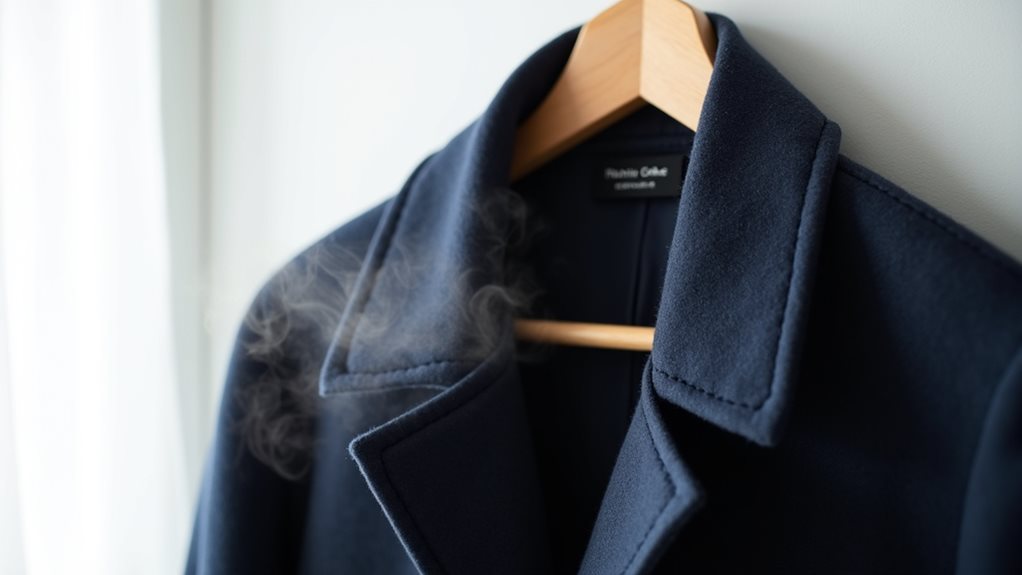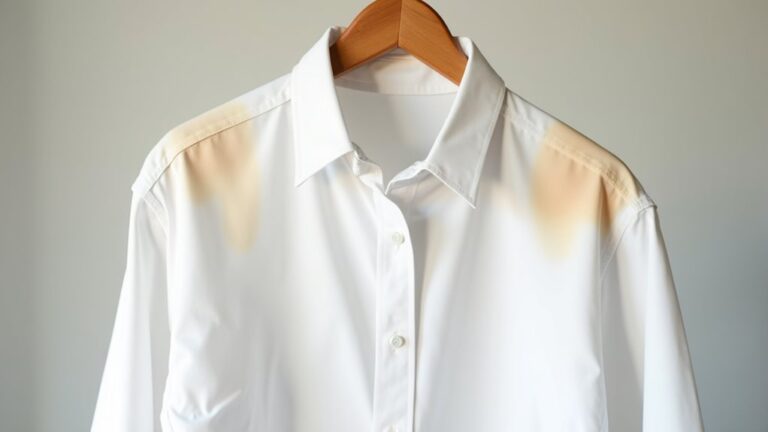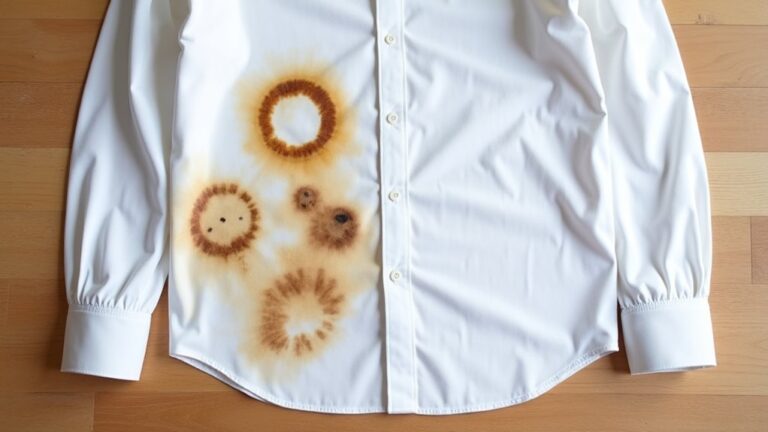Dry cleaning can tackle many stubborn odors like sweat, smoke, and environmental smells by using powerful solvents that penetrate deep into fabric fibers, dissolving the oils and compounds that cause those persistent scents. However, it’s not foolproof—some odors like pet urine, strong perfumes, or deeply embedded cooking smells may survive the process, especially in synthetic fabrics that trap odors more stubbornly than natural fibers. Understanding which smells respond best helps set realistic expectations.
Understanding the Dry Cleaning Process and Odor Removal
When I first discovered that my favorite blazer had absorbed the lingering essence of last night’s garlic-heavy dinner, I wondered if dry cleaning could actually rescue it from smelling like an Italian restaurant.
The dry cleaning process works differently than your washing machine, using powerful solvents like perchloroethylene that literally dissolve oils and grime trapped in fabric fibers.
While regular detergent just pushes surface dirt around, these specialized chemicals actually break down the molecular compounds causing unpleasant smells, making dry cleaning surprisingly effective for odor removal.
Think of it as garment care surgery rather than a simple rinse – the solvents penetrate deep into fibers to remove smells at their source, giving your clothes a genuine fresh start instead of temporary masking.
This makes dry cleaning particularly successful for delicate fabrics and structured garments where traditional washing methods might damage the material while failing to eliminate stubborn odors.
Types of Odors That Dry Cleaning Can Eliminate

You’ve probably wondered which specific odors can actually disappear when you drop off those favorite clothes at the dry cleaner, and honestly, the results might surprise you more than they did me when I first discovered this game-changing solution.
The two most common culprits that dry cleaning tackles remarkably well are sweat and body odors that seem permanently embedded in your garments, plus those stubborn smoke and environmental smells that cling to fabric like they’re paying rent 😅.
Whether it’s that persistent cigarette smell from a night out or the campfire scent that’s overstayed its welcome on your jacket, dry cleaning’s specialized solvents work their magic by penetrating deep into fibers where regular washing simply can’t reach.
Beyond just removing odors, the chemical solvents used in dry cleaning also eliminate odor-causing bacteria and microorganisms that contribute to persistent smells in fabrics.
Sweat and Body Odors
While we’d all love to pretend our clothes magically stay fresh after every wear, the truth is that sweat and body odors have a sneaky way of clinging to our favorite garments, especially after those particularly intense days at work or the gym.
Thankfully, dry cleaning can be your secret weapon against these stubborn smells, using powerful solvents to break down the oils and bacteria that make your clothes less than pleasant.
Here’s how dry cleaning tackles sweat and body odors:
- Penetrates deep into fabric fibers using perchloroethylene to dissolve embedded oils
- Works especially well on natural fibers like wool and silk compared to synthetic materials
- Requires regular maintenance every few wears to prevent odor buildup
However, the solvents used in dry cleaning are particularly effective at removing oil-based components of sweat but may struggle more with water-soluble salts and proteins that also contribute to odors.
Trust me, your clean clothes will thank you!
Smoke and Environmental Smells
Beyond sweat and body odors, you’ll encounter an entirely different category of stubborn smells that seem to follow you home like unwanted guests. I’m talking about those persistent smoke and environmental odors that cling to your clothes with surprising tenacity.
Whether you’ve spent an evening around a bonfire or walked through someone’s cigarette cloud, dry cleaning becomes your secret weapon against these invasive scents. The specialized solvents used in professional dry cleaning don’t just surface-clean your garments—they dive deep into fabric fibers, targeting smoke odors and environmental smells at their source.
This thorough odor removal process transforms your clothes from “smoky disaster” back to “fresh and confident,” especially when dealing with delicate natural fibers like wool and silk. Professional cleaners often enhance their smoke odor removal capabilities using ozone chambers specifically designed to neutralize the most stubborn smells.
Why Some Smells Persist After Dry Cleaning
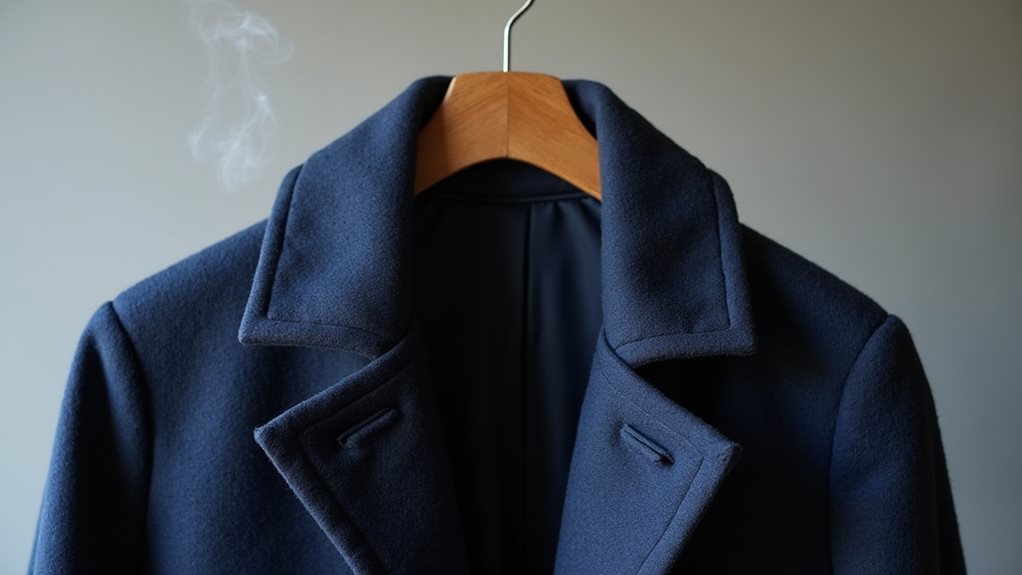
You’ve probably experienced that frustrating moment when you pick up your “freshly” dry-cleaned blazer, only to catch a whiff of that stubborn cologne or coffee shop aroma that somehow survived the professional treatment 😅.
The truth is, some odors burrow so deep into fabric fibers that they become like unwelcome houseguests who refuse to leave, no matter how many hints you drop.
When dry cleaning establishments rush through their process or use shortcuts like light pressing instead of thorough cleaning, those persistent smells stick around to remind you that not all cleaning methods are created equal.
While dry cleaning uses chemical solvents that can penetrate fabric fibers more effectively than water-based washing, extremely stubborn odors like strong perfumes, gasoline, or pet urine may require multiple treatments to achieve complete removal.
Deep Fabric Penetration
Although dry cleaning’s powerful solvents work wonders on surface-level odors, they sometimes struggle to reach the deepest layers of fabric where stubborn smells love to hide and make themselves at home.
Think of it like trying to clean a sponge – you can scrub the outside all you want, but those deep-rooted odors burrow into the fiber’s core like unwelcome houseguests who refuse to leave.
Here’s why deep fabric penetration becomes tricky for odor removal:
- Natural fibers like wool and silk act like tiny smell sponges, trapping odors in their complex structure.
- Layered fabrics create multiple hiding spots where solvents can’t always penetrate effectively.
- Time factors allow smells to bond chemically with fibers, making them nearly impossible for standard dry cleaning to remove completely.
Adding to this challenge, perchloroethylene (PERC) – the most common dry cleaning solvent – can sometimes leave its own chemical odor on fabrics if the cleaning equipment isn’t properly maintained or if garments aren’t adequately aired out after the process.
Inadequate Cleaning Process
The real culprit behind persistent odors often isn’t the dry cleaning solvent itself, but rather shortcuts and corner-cutting that happen behind the scenes at your local cleaner.
When dry cleaning works properly, it should remove smells effectively, but many establishments skip essential steps in their cleaning processes.
You’ve probably experienced this frustration—dropping off a stinky blazer only to pick it up still reeking 😤.
Sometimes cleaners simply press garments without proper solvent exposure, creating the illusion of cleanliness.
Insufficient drying time leaves residual moisture that breeds bacteria, while synthetic fibers require longer treatment cycles that rushed operations often ignore.
These persistent odours aren’t your imagination; they’re evidence of inadequate care and attention to detail.
Poor ventilation in facilities can also contribute to odor problems, as garments may not receive adequate airing time during the final stages of the cleaning process.
Limitations of Dry Cleaning for Specific Odor Types
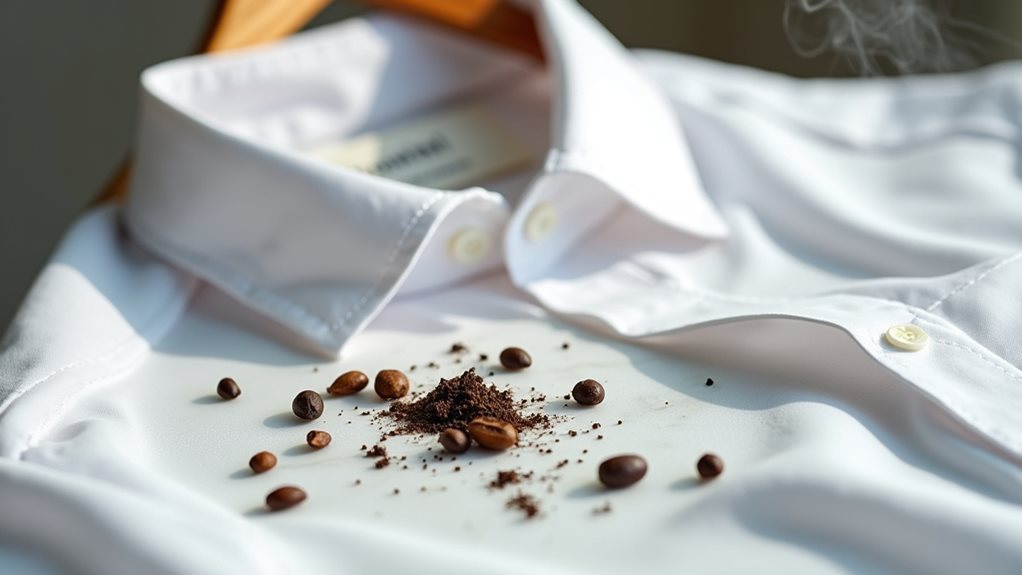
While dry cleaning works wonders for many stains and odors, it’s not the magic solution I once believed it to be, especially when you’re dealing with certain stubborn smells that seem determined to cling to your favorite garments.
Dry cleaning isn’t the miracle cure for stubborn odors that many of us hope it will be.
Through trial and error (and some expensive cleaning bills 😅), I’ve learned that dry cleaning has real limitations when it comes to specific odor types.
Here’s what you should know about dry cleaning’s blind spots:
- Sweat and perspiration odors penetrate deep into fabric layers, often beyond where solvents can reach effectively.
- Oil-based smells from cigarettes or cooking require water-based pre-treatment, which isn’t part of standard dry cleaning.
- Pet and food odors frequently survive the process, especially in synthetic fabrics that trap smells more stubbornly than natural fibers.
Understanding these limitations helps you choose better cleaning methods. Beyond odor removal concerns, it’s worth noting that perchloroethylene (PERC), the most commonly used dry cleaning solvent, has been classified as a probable human carcinogen, which is why many facilities are transitioning to safer alternatives.
Alternative Methods to Enhance Odor Removal

Several months ago, when my favorite wool blazer emerged from the dry cleaner still carrying hints of that embarrassing garlic bread incident from dinner, I realized I needed to become my own odor-removal detective 🕵️♀️.
While dry cleaning offers excellent results, sometimes you’ll need backup strategies to completely remove odors that cling stubbornly to fabrics.
Start by ventilating clothing in fresh air near an open window, which works surprisingly well for dissipating chemical smells.
For persistent odors, mix white vinegar with water and lightly spray the fabric, testing an inconspicuous area first.
Fabric fresheners provide that final pleasant touch, while ground coffee in sealed bags absorbs stubborn smells overnight.
Regular airing and proper storage help prevent buildup between cleanings.
When dealing with particularly challenging odors like smoke, the specialized solvents used in professional dry cleaning can break down odor-causing particles that penetrate deep into fabric fibers.
Choosing the Right Cleaning Method for Your Garments

Since discovering that my delicate silk scarf required completely different care than my sturdy denim jacket, I’ve learned that choosing the right cleaning method isn’t just about convenience—it’s about preserving your clothes and guaranteeing they smell fresh for years to come.
The right cleaning method isn’t just about convenience—it’s about preserving your clothes and keeping them fresh for years.
Here’s my simple approach to picking the right method:
- Delicate fabrics like wool, silk, and cashmere should go straight to your dry cleaner, where specialized solvents can remove odors without damaging fibers.
- Heavily soiled items need pre-treatment before any cleaning method—whether that’s spot-treating stains or discussing stubborn smells with your cleaner.
- Everyday cotton and synthetics can usually handle regular washing, but don’t hesitate to dry clean special pieces.
The science behind dry cleaning solvents like perchloroethylene allows them to dissolve oils and odor-causing compounds without the structural damage that water-based washing can cause to sensitive materials.
Trust me, your wardrobe will thank you!

